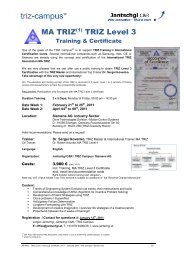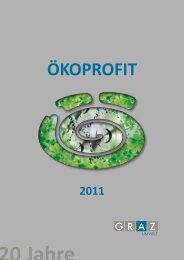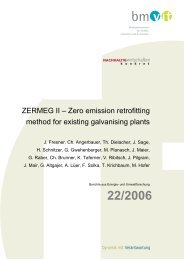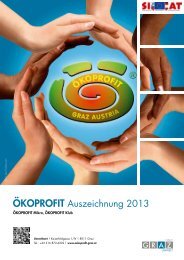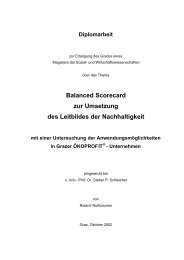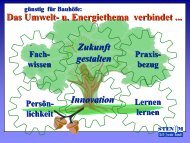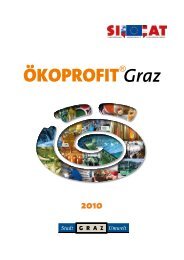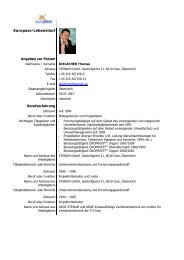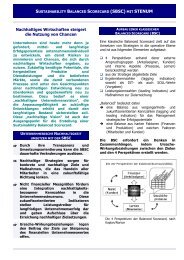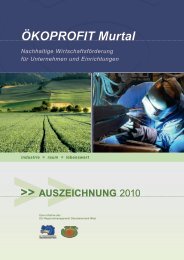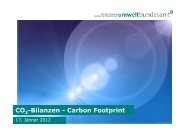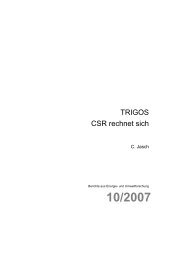Promoting Resource Efficiency in Small & Medium size ... - UNEP
Promoting Resource Efficiency in Small & Medium size ... - UNEP
Promoting Resource Efficiency in Small & Medium size ... - UNEP
You also want an ePaper? Increase the reach of your titles
YUMPU automatically turns print PDFs into web optimized ePapers that Google loves.
9.3 Benchmarks for paper production<br />
Table 27 gives benchmarks for the water consumption for different types<br />
of products for paper mills.<br />
Process<br />
Specific water consumption<br />
[m³/t]*<br />
Uncoated fold<strong>in</strong>g boxboard 2 – 10<br />
Coated fold<strong>in</strong>g boxboard 7 – 15<br />
Corrugated medium & packag<strong>in</strong>g<br />
paper<br />
1.5 – 10<br />
Newspr<strong>in</strong>t 10 – 20<br />
Tissue 5 – 100<br />
Writ<strong>in</strong>g and pr<strong>in</strong>t<strong>in</strong>g paper 7 – 20<br />
Table 27: Water consumption <strong>in</strong> the paper <strong>in</strong>dustry<br />
Notes:<br />
* It has been noted that about 1.5 m³ water per tonne of paper is vaporised <strong>in</strong><br />
the dryer section of the paper mach<strong>in</strong>e, this means that it does not appear as<br />
wastewater.<br />
Table 28 gives benchmarks for the water discharge for different types of<br />
products for paper mills.<br />
Paper grade Water discharge [m³/t] Remarks<br />
Tissue 10 1 – 50 For recycled fibre based tissue: <strong>in</strong>cludes fibre process<strong>in</strong>g<br />
Pr<strong>in</strong>t<strong>in</strong>g/writ<strong>in</strong>g, uncoated 51 – 402 May <strong>in</strong>clude water used <strong>in</strong> pulp process<strong>in</strong>g<br />
Pr<strong>in</strong>t<strong>in</strong>g/writ<strong>in</strong>g, coated 51 – 50 May <strong>in</strong>clude water used <strong>in</strong> pulp process<strong>in</strong>g<br />
Paper board 01 – 20 Includes water used <strong>in</strong> pulp process<strong>in</strong>g<br />
Speciality paper 10 – 3003<br />
Table 28: Water discharge <strong>in</strong> European mills<br />
Notes:<br />
1) The lower end of the range is changed by EIPPCB accord<strong>in</strong>g to current performance data<br />
2) The higher end of the range is changed by EIPPCB because the given figure of 90 m³/ADt seems to be unrealistically high<br />
3) The higher end of the range is changed by EIPPCB because the given figure of 400 m³/ADt seems to be unrealistically high<br />
Table 29 and Table 30 give benchmarks for the energy consumption for<br />
different types of products for paper mills.<br />
Type of mill<br />
Process heat<br />
consumption<br />
(net) <strong>in</strong> GJ/ADt<br />
Non-<strong>in</strong>tegrated bleached sulphite pulp 16 – 18 0.7 – 0.8<br />
Integrated bleached sulphite pulp and coated<br />
f<strong>in</strong>e paper<br />
Integrated bleached sulphite pulp and<br />
uncoated f<strong>in</strong>e paper<br />
Table 29: Heat and power consumption <strong>in</strong> paper-mak<strong>in</strong>g<br />
Power consumption<br />
(net) <strong>in</strong> MWh/ADt<br />
Remarks<br />
17 – 23 1.5 – 1.75 Paper dry<strong>in</strong>g is more energy consum<strong>in</strong>g than pulp dry<strong>in</strong>g<br />
18 – 24 1.2 – 1.5 Fillers and surface <strong>size</strong> 10 – 30%<br />
Notes:<br />
The units can be converted from MWh to GJ accord<strong>in</strong>g to 1 MWh = 3.6 GJ and 1 GJ = 0.277 MWh<br />
93



